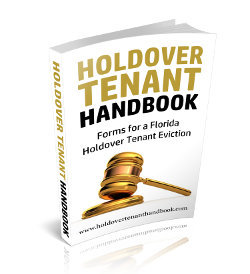A holdover eviction can be a powerful tool in the Landlord’s tool belt. Often in non-payment of rent and material violation of the lease besides non-payment of rent evictions (7 day notice evictions), the tenants have a wide range of defenses that they can try to raise. For example, in non-payment of rent cases they can argue that the rent alleged by the landlord isn’t correct, or that they have performed repairs that should entitle them to an offset. In seven day notice evictions it can be very difficult to prove the tenant’s breach. Enter the holdover eviction. A holdover eviction can be used when the lease either expires naturally, or is terminated by one of the parties, and the tenant refuses to vacate the premises and instead “holds over”. Although I have seem some creative arguments to fight a holdover eviction, the fact remains that it is much harder for a tenant to wiggle out of.
Click here to purchase the Holdover Tenant Eviction Forms Pack.
This article should provide a general overview of the holdover tenant process. Before moving any further through this article, please understand that your best bet when contemplating the eviction of a tenant, is to consult an experienced landlord tenant lawyer. You can read articles on the internet until you are blue in the face, but there is no replacement for competent legal advice from a lawyer who has been there and done that time and time again.
With that said, this article is designed to provide the reader with a brief overview and understanding of the process.
Step 1 – Terminate the Lease
If there is no written lease, then you have an oral lease. These are generally presumed to be “at will” tenancies, and they are terminable by providing notice under the Florida Statute.
If there is a written lease in place, you will want to see if you can use the lease to terminate the tenancy. If the lease has an expiration date and a notice clause, be sure to review the notice clause to see what kind of notice you need to give the tenant to let the tenant know that the lease will not be reviewed. If the written lease is a month to month lease, look for a specific termination clause. Florida Statue allows for a 30 day notice provision for a month-to-month lease, but if you have a written lease with a longer notice provision (eg, the lease says you need to provide 45 days notice prior to termination), then the lease will control. The lease will not control if the notice provision is less than the Florida statute.
Step 2 – File Suit
If the tenant remains on the premises after the notice period, then your next step is to file a lawsuit in County Court. To do that, you will need to draft a complaint telling the Court what happened (you had a lease with a tenant, you terminated the lease and asked the tenant to leave, and the tenant refuses to leave) and what you want the Court to do (kick the tenant out and give you possession). You will also need a summons for each defendant you have named in your complaint. You will want to speak with your local Clerk of Court to get the specifics for the summons, but the Clerk will tell you that you have to draft your own complaint.
Step 3 – Serve the Tenant
Once your complaint has been filed and your summons has been issued, you will want to have your summons and complaint served upon your tenant. You will need to either hire a private process server or the Sheriff to do that for you. Typically they will charge you $40 to serve the complaint and summons.
Step 4 – Wait for the Tenant to Respond to your Lawsuit
The tenant has 5 business days after he has been served to respond to your complaint. Sometimes the tenant will not respond, other times they will respond. After the 5 days have tolled, check in on the status of the case.
Move forward with a Default, or Deal with the Response
If after the 5 days tolls the tenant fails to respond to the complaint by filing papers with the Clerk, you can move forward with obtaining a default judgment. First you will need to obtain a default clerk, or clerk’s default as they are sometimes called. After you have obtained a clerk’s default you can motion the judge for a final judgment granting possession.
If the tenant does file a response, then you may have to attend a hearing. It will depend on what the response states and what the judge wants to do.
Evicting Florida Holdover Tenants – Final Thoughts
Evicting a holdover tenant, like any legal proceeding, can be a mixed bag. If the tenants don’t put up a fight then it’s possible to sail through the process. If the tenants put up a fight, then it will all come back to ensuring that the notice was properly served, the complaint properly drafted, and all the other rules of landlord tenant law were followed. It will depend much on the Judge the case is assigned to, as they vary wildly from pro-landlord to pro-tenant.
It’s recommended to hire an attorney from the start, but if you want to further understand the holdover tenant eviction process or even brave the challenge yourself, then forms can be purchased on this very website.
Click here to purchase the Holdover Tenant Eviction Forms Pack.
